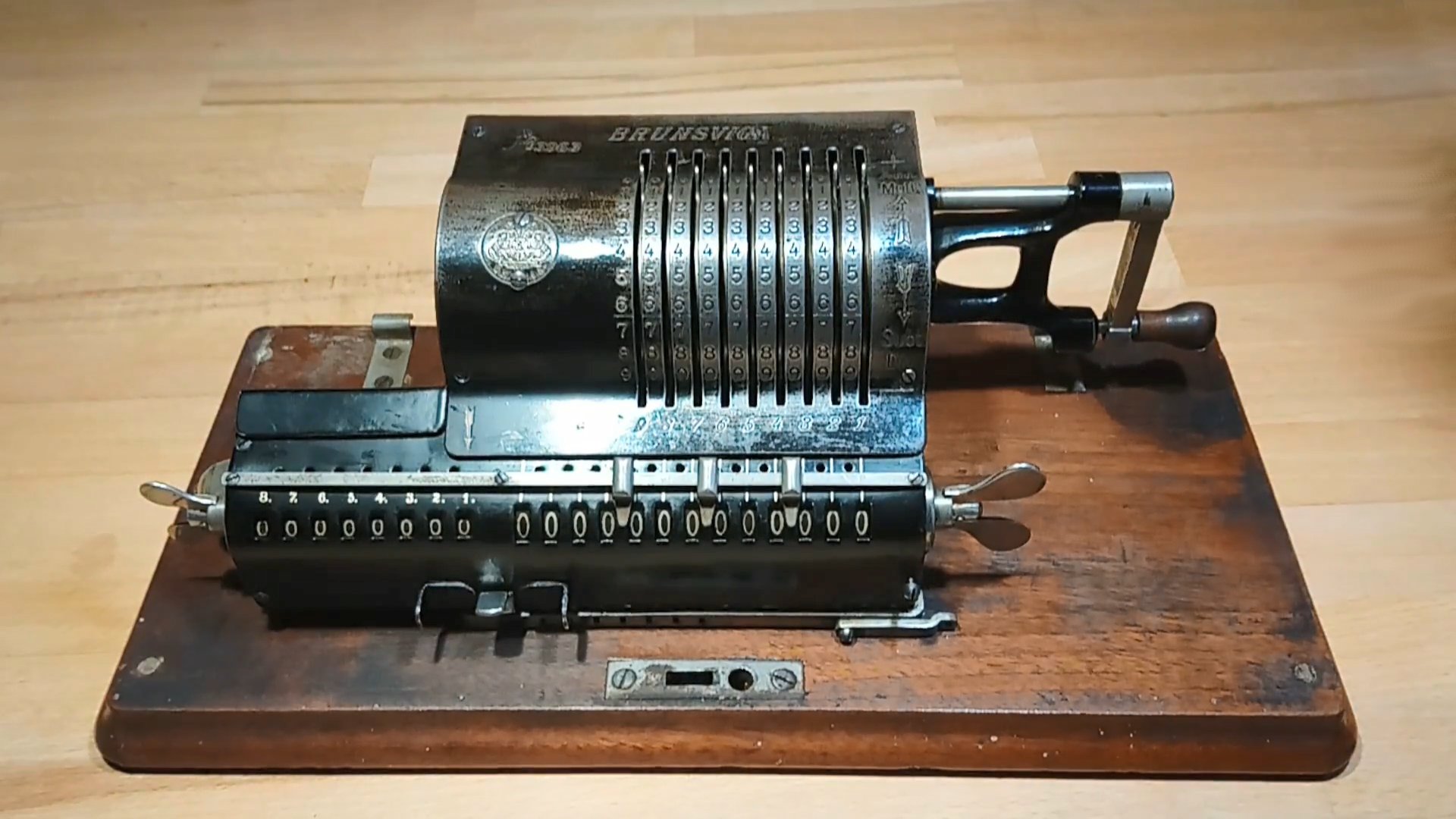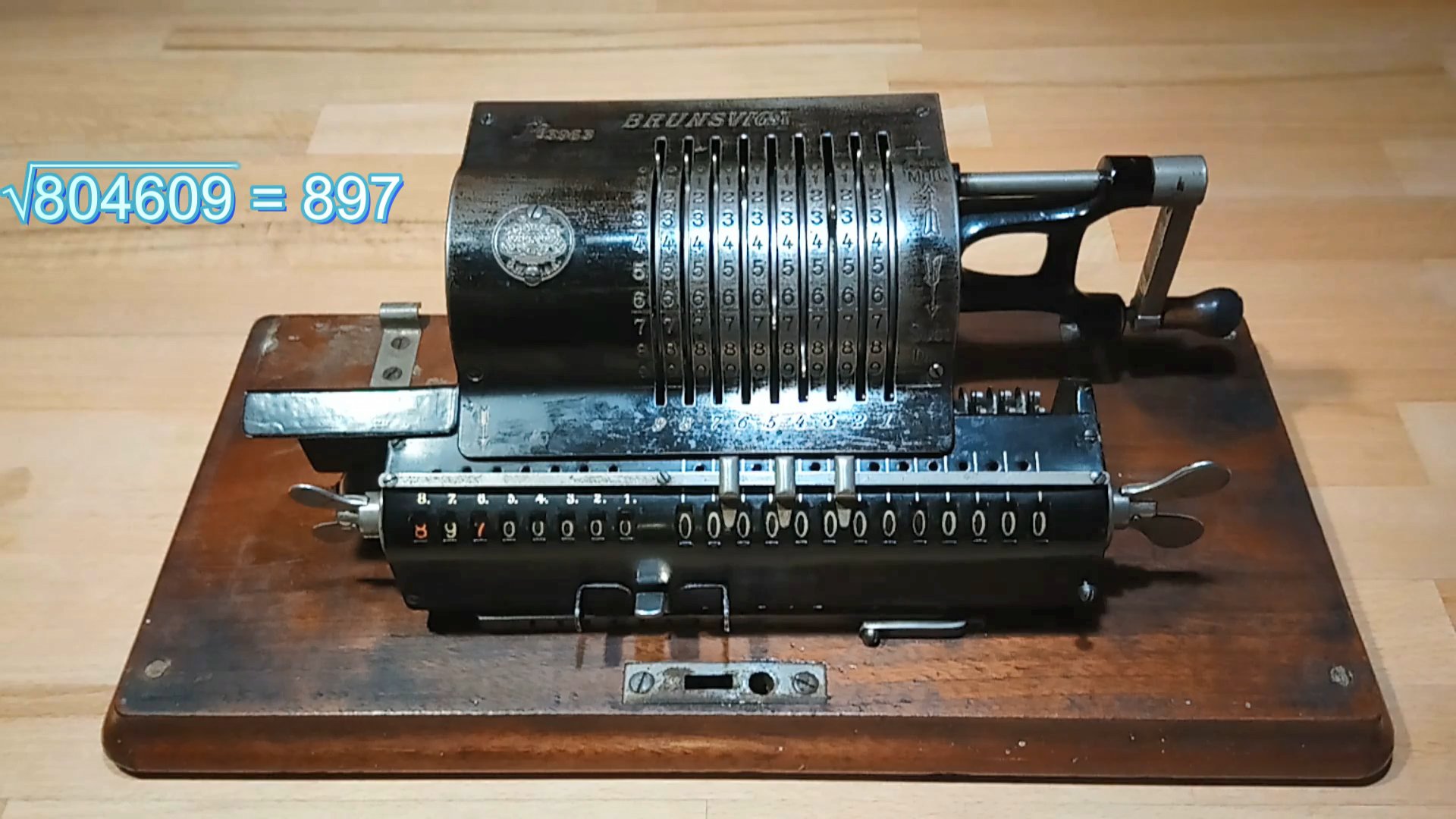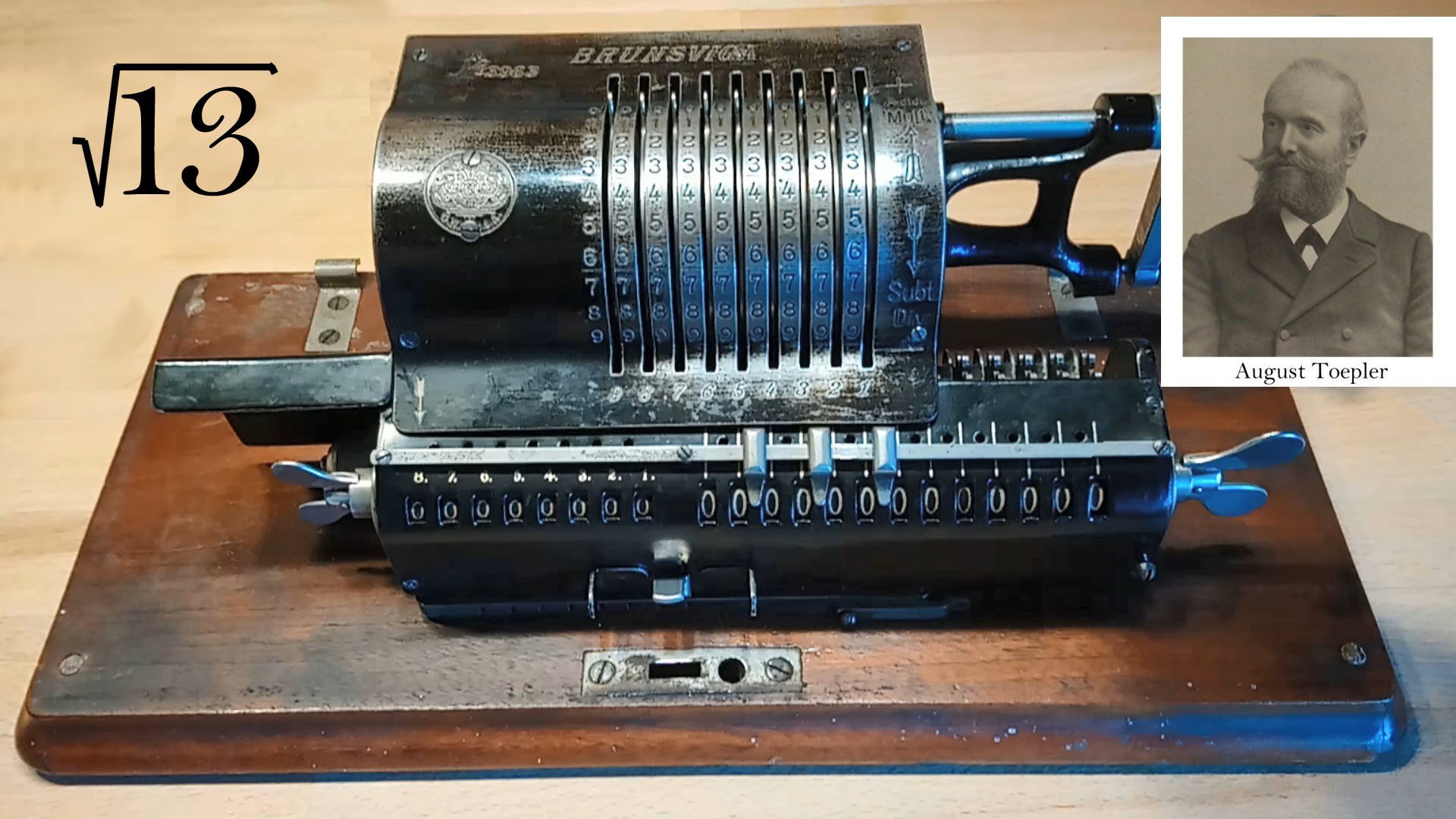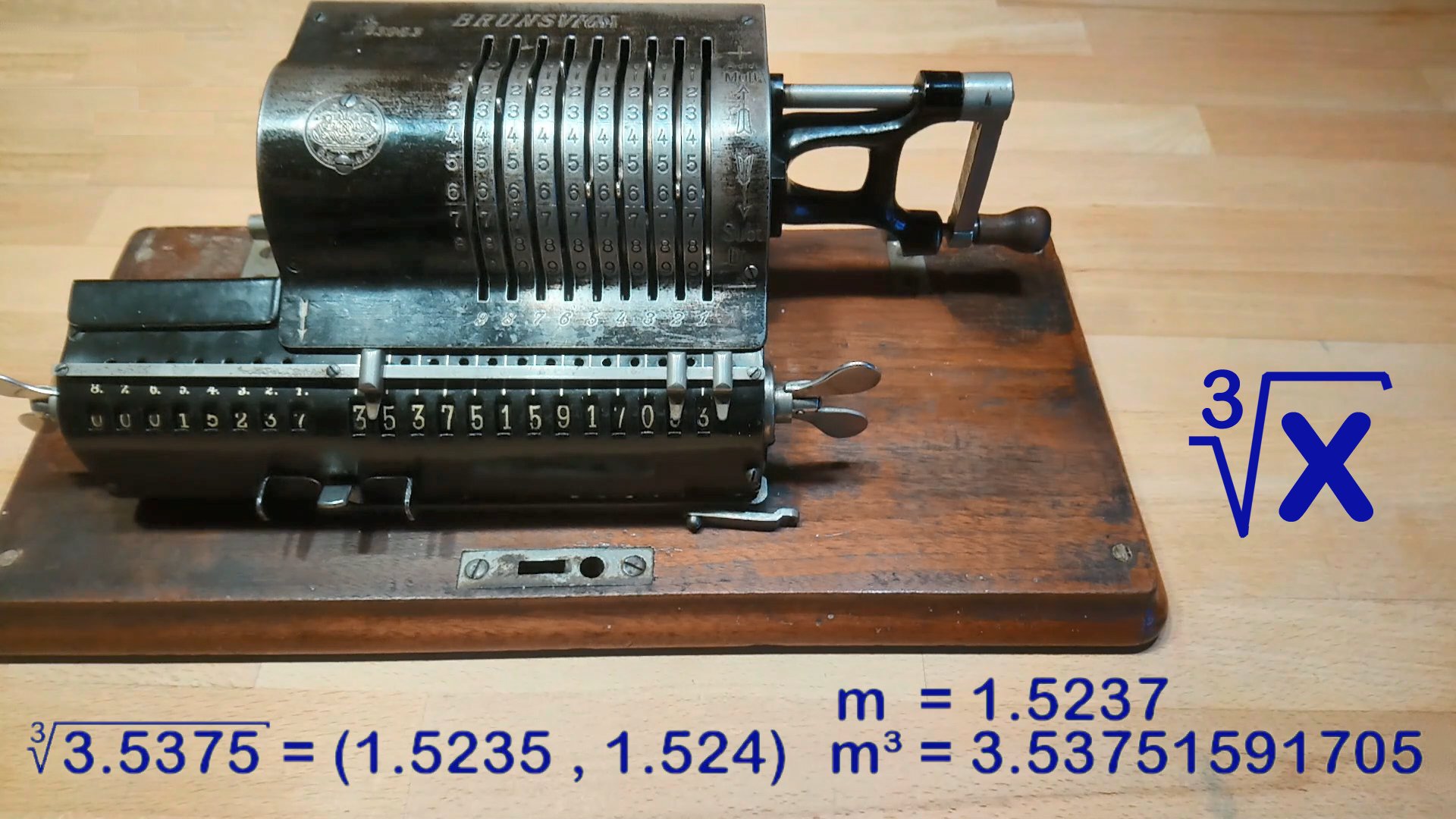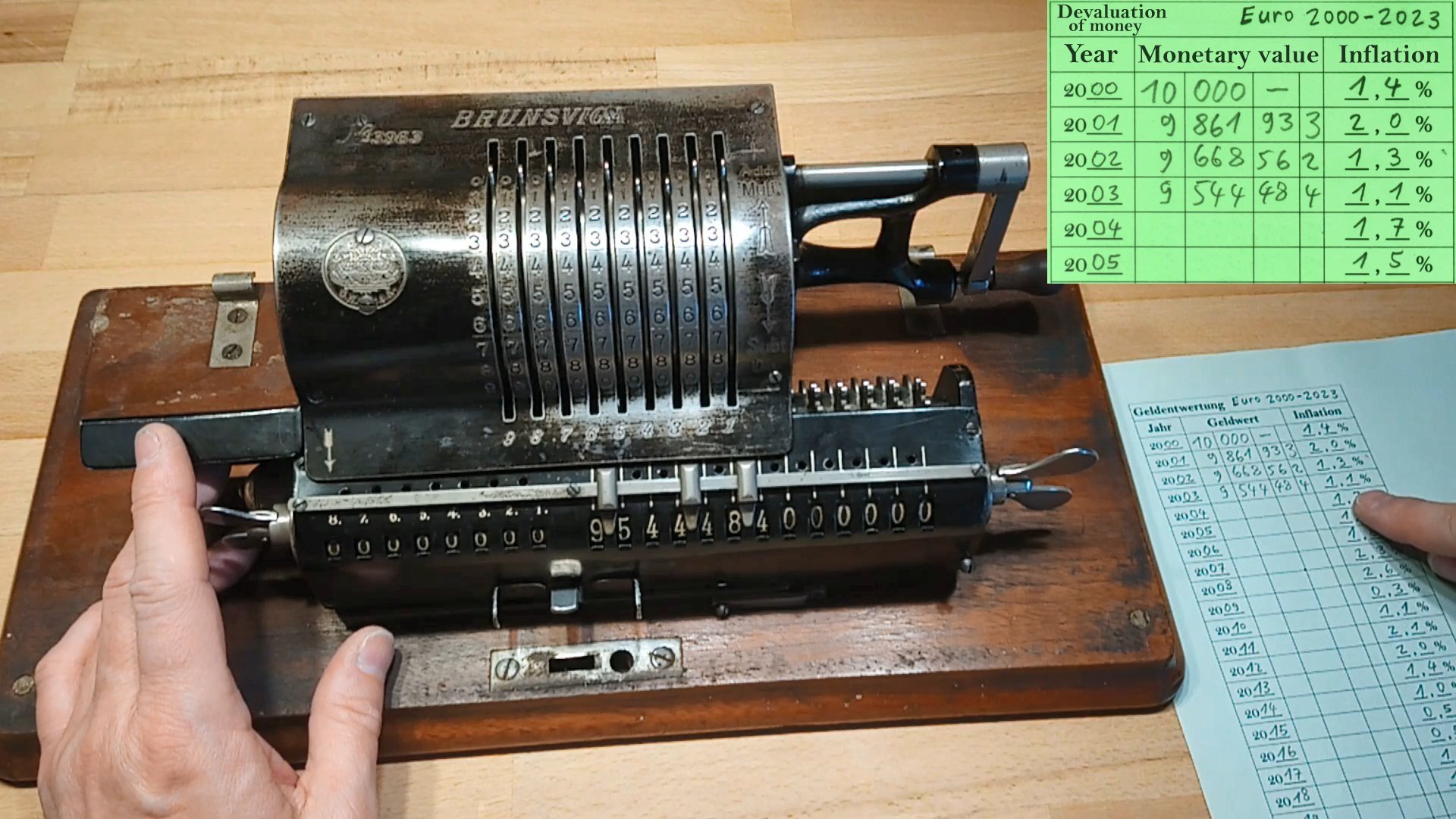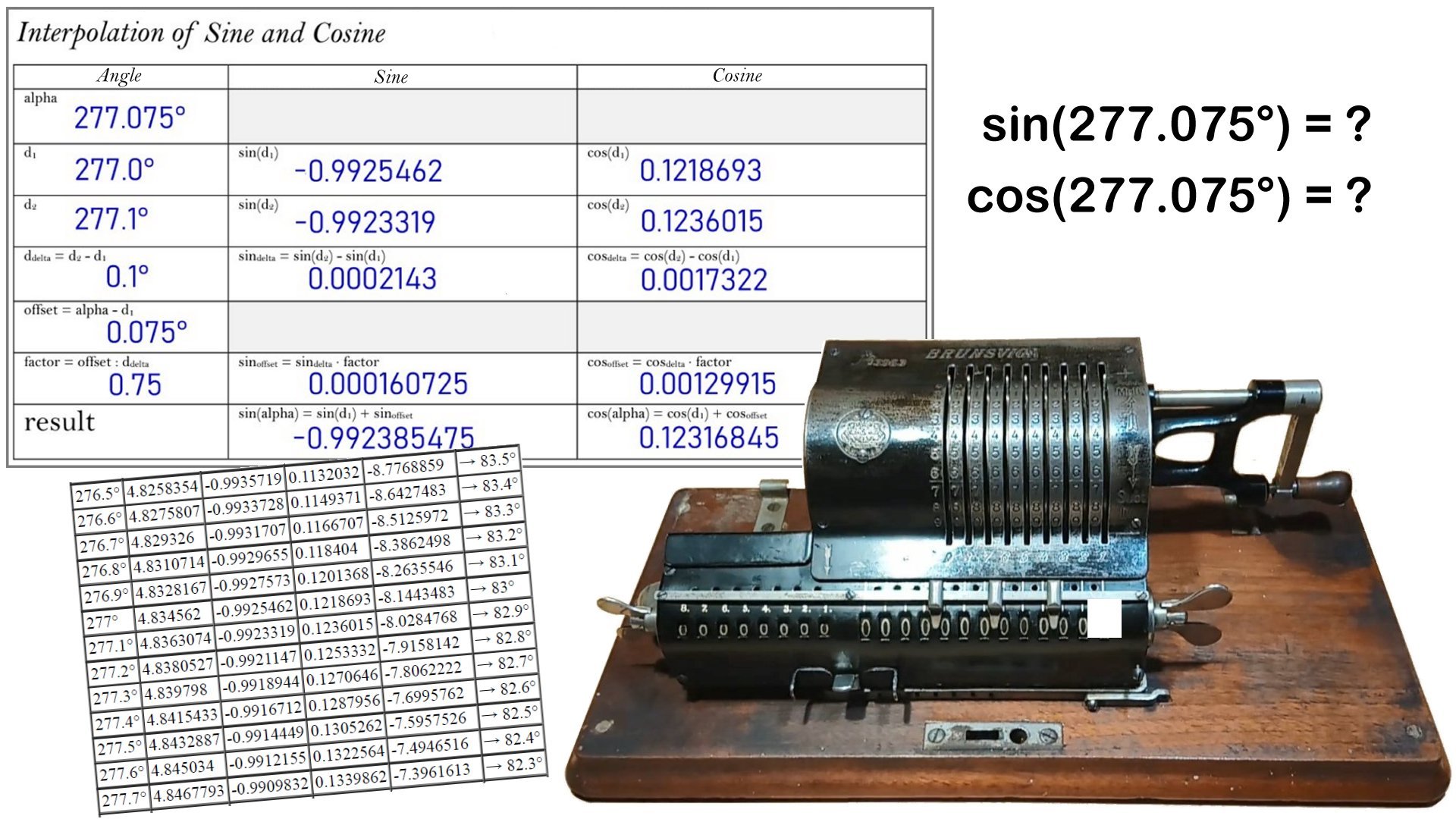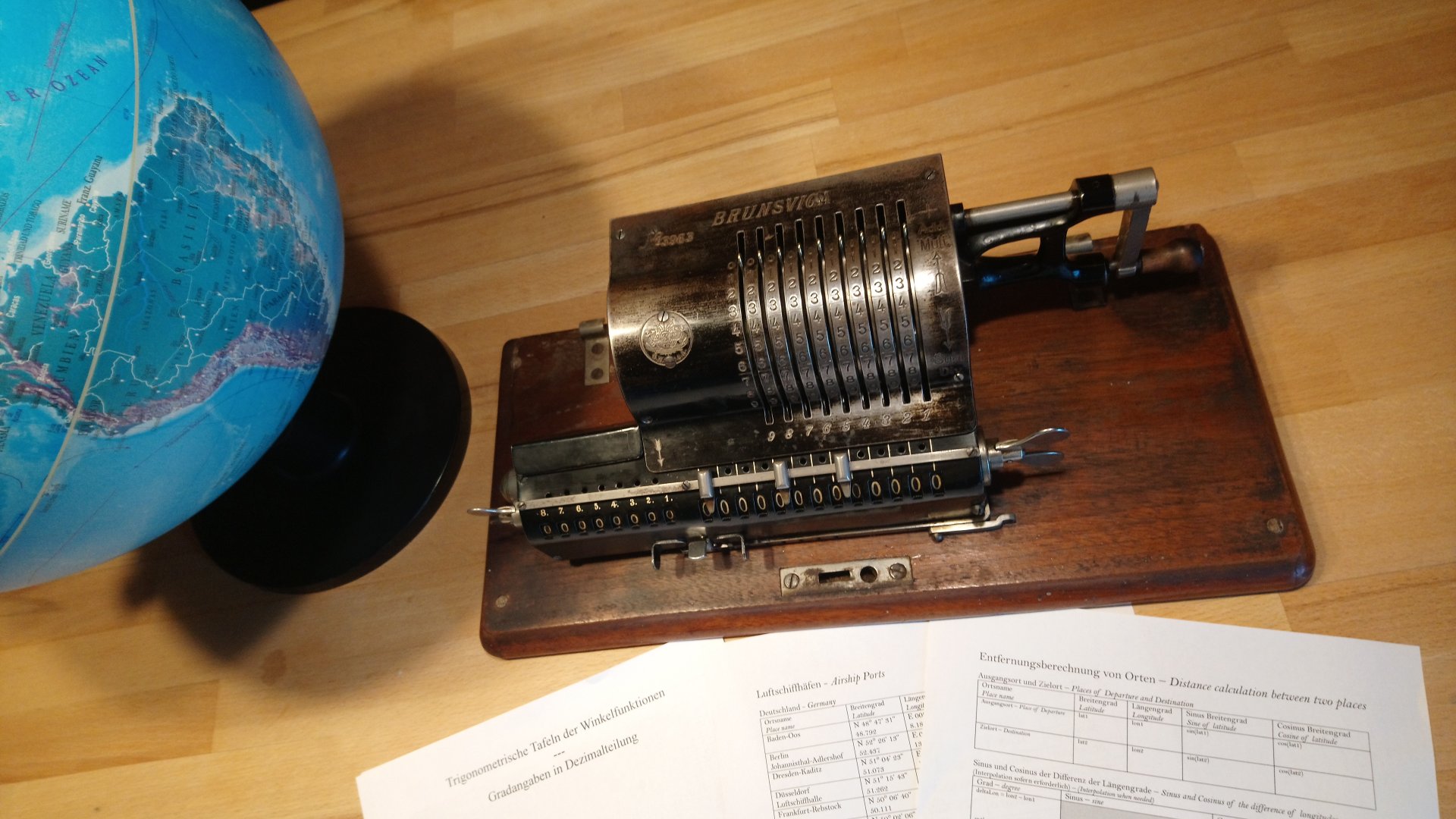Calculating with Mechanical Calculators
This tutorial explains how to use mechanical calculators of the Odhner system to perform the
four basic arithmetic operations and also how to calculate square roots.
This includes not only the Original Odhner machines, but also its clones like the Brunsviga models A, B, C, D, E, F, M, MA, MB and MD,
and also similar mechanical calculators of other manufacturers.
- Components of the Mechanical Calculator
- Explanation of the arithmetic operations
- Addition
- Subtraction
- Multiplication
- Division
- Calculating Square Roots (Toepler's method)
- Videos
Components of the Mechanical Calculator
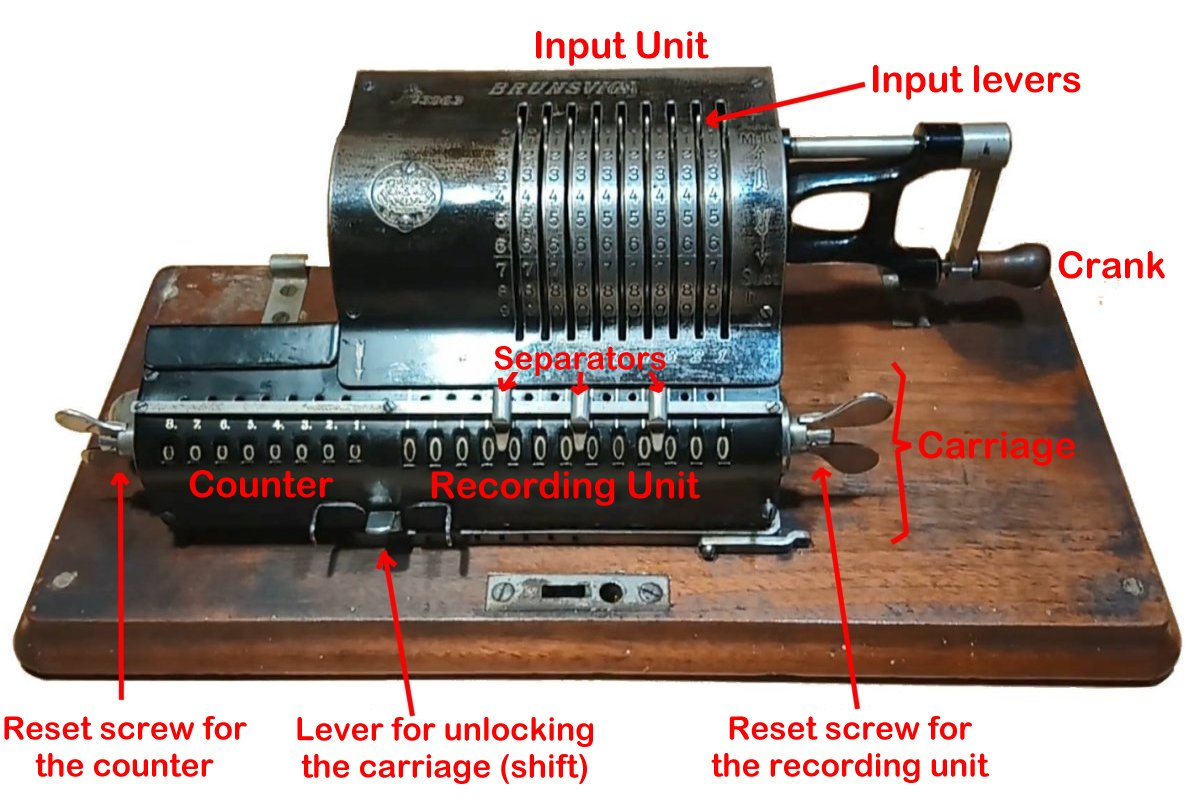
- Turning the crank clockwise (1x +) will add the number in the input unit to the recording unit.
- Turning the crank counterclockwise (1x -) will subtract the number in the input unit from the recording unit.
- While pushing down the unlocking lever, the carriage can be shifted to the left or to the right. This is needed for multiplications and divisions.
- The separators can be used to mark decimal places.
- Before starting a new calculation, the recording unit and the counter have to be resetted to zero and the input levers should be moved back to their zero positions. The carriage should be moved completely to the left to its default position.
Capacity of the calculator
The capacity of mechanical calculators is defined by the ratio of three components:
the number of digits that can be processed in the input unit, the recording unit and in the counter.
The capacity is usually given as input unit x recording unit x counter.
The capacity is usually given as input unit x recording unit x counter.
The Brunsviga Modell B shown above has a Capacity of 9 x 13 x 8.
Explanation of the arithmetic operations
Crank
| crank | meaning |
| 1x + | turn crank one time clockwise (addition) |
| 1x - | turn crank one time counterclockwise (subtraction) |
Carriage
| carriage | meaning |
| ←1 | shift carriage one position to the left |
| 1→ | shift carriage one position to the right |
| |← | move carriage completely to the left (default position) |
| →| | move carriage completely to the right |
| |IU |RU | adjust input unit and recording unit left-aligned |
Addition
Exercise 1
| Calculate the sum of 75,384 + 6,278 + 9,507 | ||||
| carriage | input unit | crank | recording unit | counter |
| (adjust left) | 000075384 | 1x + | 0000000075384 | 00000001 |
| 000006278 | 1x + | 0000000081662 | 00000002 | |
| 000009507 | 1x + | 0000000091169 | 00000003 | |
| result | 91,169 | |||
Exercise 2
| Calculate the sum of 1521.16 + 3.5469 + 819.3 + 15.453 + 6875.82974 | ||||
| carriage | input unit | crank | recording unit | counter |
| (adjust left) | 1521.16000 | 1x + | 00001521.16000 | 00000001 |
| 0003.54690 | 1x + | 00001524.70690 | 00000002 | |
| 0819.30000 | 1x + | 00002344.00690 | 00000003 | |
| 0015.45300 | 1x + | 00002359.45990 | 00000004 | |
| 6875.82974 | 1x + | 00009235.28964 | 00000005 | |
| result | 9235.28964 | |||
Subtraction
Exercise 3
| Calculate the difference of 2,765,930 - 2,748,693 | ||||
| carriage | input unit | crank | recording unit | counter |
| (adjust left) | 002765930 | 1x + | 0000002765930 | 00000001 |
| 002748693 | 1x - | 0000000017237 | 00000000 | |
| result | 17,237 | |||
Multiplication
Exercise 4
| Calculate the product of 3600 x 24 x 365 (seconds per year) | ||||
| carriage | input unit | crank | recording unit | counter |
| (adjust left) | 000003600 | 4x + | 0000000014400 | 00000004 |
| 1→ | 000003600 | 2x + | 0000000086400 | 00000024 |
| |← | 000086400 | (-) | reset | reset |
| (adjust left) | 000086400 | 5x + | 0000000.432000 | 00000005 |
| 1→ | 000086400 | 6x + | 0000005616000 | 00000065 |
| 1→ | 000086400 | 3x + | 0000031536000 | 00000365 |
| result | 31,536,000 (seconds per year) | |||
Exercise 5
| Calculate the product of 187 x 4.689 | ||||
| carriage | input unit | crank | recording unit | counter |
| (adjust left) | 000004.689 | 7x + | 0000000032.823 | 00000007 |
| 1→ | 000004.689 | 8x + | 0000000407.943 | 00000087 |
| 1→ | 000004.689 | 1x + | 0000000876.843 | 00000187 |
| result | 876.843 | |||
Exercise 6
| Calculate the product of 521.735 x 0.25 | ||||
| carriage | input unit | crank | recording unit | counter |
| (adjust left) | 000521.735 | 5x + | 00000026.08675 | 00000005 |
| 1→ | 000521.735 | 2x + | 00000130.43375 | 00000025 |
| result | 130.43375 | |||
| Both multiplied numbers have five decimal places combined. Therefore the result has five decimal places. | ||||
Division
For the calculation of divisions, the dividend should be entered left-aligned into the recording unit.
Then the divisor has to be entered in the input unit directly at the leftmost possible position where it is less or equal the digit sequence in the recording unit.
Then the dividend in the recording unit is eliminated step by step by subtracting the divisor until the number in the recording unit is less than the divisor in the input unit.
Now the carriage has to be shifted one position to the left, until the number in the recording unit again is greater or equal the number in the input unit.
Then we proceed as above, by continously subtracting the divisor from the number in the recording unit. When the number in the recording unit is completely eliminated,
the result of the division is given in the counter (in red digits).
Exercise 7
| Calculate the division of 277204 / 37 | ||||
| carriage | input unit | crank | recording unit | counter |
| |← | reset all | ____000000000 0000000000000 | 00000000 | |
| 4→ | 277204|000 000000|0000000 | 1x + | 277204|000 277204|0000000 | 00010000 reset! |
| 3→ | 000037000| ___277204|0000000 | 7x – | 000037000| ___018204|0000000 | 70000000 |
| ←1 | 00003700|0 __018204|0000000 | 4x – | 00003700|0 __003404|0000000 | 74000000 |
| ←1 | 0000370|00 _003404|0000000 | 9x – | 0000370|00 _000074|0000000 | 74900000 |
| ←1 | 000037|000 000074|0000000 | 2x – | 000037|000 000000|0000000 | 74920000 |
| result | 277204 / 37 = 7492 | |||
Exercise 8
| Calculate the division of 254 / 19 (floating point division) | ||||
| carriage | input unit | crank | recording unit | counter |
| |IU |RU | 254000000 0000000000000 | 1x + | 254000000 2540000000000 | 00010000 reset! |
| →| | 000190000 ___2540000000000 | 1x - | 000190000 ___0640000000000 | 10000000 |
| ←1 | 000190000 __0640000000000 | 1x - | 000190000 __0450000000000 | 11000000 |
| 000190000 __0450000000000 | 1x - | 000190000 __0260000000000 | 12000000 | |
| 000190000 __0260000000000 | 1x - | 000190000 __0070000000000 | 13000000 | |
| ←1 | 000190000 _0070000000000 | 1x - | 000190000 _0051000000000 | 13100000 |
| 000190000 _0051000000000 | 1x - | 000190000 _0032000000000 | 13200000 | |
| 000190000 _0032000000000 | 1x - | 000190000 _0013000000000 | 13300000 | |
| ←1 | 000190000 0013000000000 | 1x - | 000190000 0011100000000 | 13310000 |
| 000190000 0011100000000 | 1x - | 000190000 0009200000000 | 13320000 | |
| 000190000 0009200000000 | 1x - | 000190000 0007300000000 | 13330000 | |
| 000190000 0007300000000 | 1x - | 000190000 0005400000000 | 13340000 | |
| 000190000 0005400000000 | 1x - | 000190000 0003500000000 | 13350000 | |
| 000190000 0003500000000 | 1x - | 000190000 0001600000000 | 13360000 | |
| ←1 | _000190000 0001600000000 | 1x - | _000190000 0001410000000 | 13361000 |
| _000190000 0001410000000 | 1x - | _000190000 0001220000000 | 13362000 | |
| _000190000 0001220000000 | 1x - | _000190000 0001030000000 | 13363000 | |
| _000190000 0001030000000 | 1x - | _000190000 0000840000000 | 13364000 | |
| _000190000 0000840000000 | 1x - | _000190000 0000650000000 | 13365000 | |
| _000190000 0000650000000 | 1x - | _000190000 0000460000000 | 13366000 | |
| _000190000 0000460000000 | 1x - | _000190000 0000270000000 | 13367000 | |
| _000190000 0000270000000 | 1x - | _000190000 0000080000000 | 13368000 | |
| ←1 | __000190000 0000080000000 | 1x - | __000190000 0000061000000 | 13368100 |
| __000190000 0000061000000 | 1x - | __000190000 0000042000000 | 13368200 | |
| __000190000 0000042000000 | 1x - | __000190000 0000023000000 | 13368300 | |
| __000190000 0000023000000 | 1x - | __000190000 0000004000000 | 13368400 | |
| ←1 | ___000190000 0000004000000 | 1x - | ___000190000 0000002100000 | 13368410 |
| ___000190000 0000002100000 | 1x - | ___000190000 0000000200000 | 13368420 | |
| ←1 | ____000190000 0000000200000 | 1x - | ____000190000 0000000010000 | 13368421 |
| result | 254 / 19 = 13.368421 | |||
Calculating Square Roots (Toepler's method)
On mechanical calculators of the Odhner system,
square roots can be calculated using Toepler's method, which had been developed
by August Toepler (1836–1912)
specially for mechanical calculators.
The method is based on the fact that every integer square number can be calculated as the sum of odd numbers,
beginning with 1, 3, 5, and so on.
1² = 1
2² = 1 + 3 = 4 = 2 · 2
3² = 1 + 3 + 5 = (1 + 5) + 3 = 6 + 3 = 2 · 3 + 3 = 3 · 3
4² = 1 + 3 + 5 + 7 = (1 + 7) + (3 + 5) = 2 · 8 = 4 · 4
5² = 1 + 3 + 5 + 7 + 9 = (1 + 9) + (3 + 7) + 5 = 2 · 10 + 5 = 4 · 5 + 5 = 5 · 5
2² = 1 + 3 = 4 = 2 · 2
3² = 1 + 3 + 5 = (1 + 5) + 3 = 6 + 3 = 2 · 3 + 3 = 3 · 3
4² = 1 + 3 + 5 + 7 = (1 + 7) + (3 + 5) = 2 · 8 = 4 · 4
5² = 1 + 3 + 5 + 7 + 9 = (1 + 9) + (3 + 7) + 5 = 2 · 10 + 5 = 4 · 5 + 5 = 5 · 5
It is also important that each two decimal places in the square number correspond to
one decimal place of the square root.
10² = 100
√100 = 10
√100 = 10
For this reason in Toepler's method the square number is divided in groups of two digits each,
leftwards beginning with the decimal separator. When the sqare number has an odd number of decimal places, the leftmost
digit forms a group for itself.
√804609 → 80|46|09
√2 → 2
√20 → 20
√200 → 2|00
√2000 → 20|00
√2 → 2
√20 → 20
√200 → 2|00
√2000 → 20|00
√200 results in the same digit sequence as √2, only shifted by one position.
As well √2000 results in the same digit sequence as √20, also shifted by one position.
On the other hand, √2 and √20 result in completely different digit sequences:
As well √2000 results in the same digit sequence as √20, also shifted by one position.
On the other hand, √2 and √20 result in completely different digit sequences:
√2 = 1.41421356237
√200 = 10 · √2 = 14.1421356237
√20 = 4.472135955
√2000 = 10 · √20 = 44.72135955
√200 = 10 · √2 = 14.1421356237
√20 = 4.472135955
√2000 = 10 · √20 = 44.72135955
In Toepler's method every group of two decimal places is eliminated stepwise by subtracting
the forthcoming odd number, until the next odd number is greater than the remainder of the actual place.
When there's still a remainder, the forthcoming odd number is calculated by the result digit sequence found so far,
multiplied by 20 plus one. That is the starting odd number for the next decimal place. For this the remainder is
shifted one decimal place to the left (which means it is multiplied by 10).
This sounds more difficult than it really is.
Let's take a look at the following example.
With some practice, this is done quickly and safely.
(see also the video below).
With some practice, this is done quickly and safely.
(see also the video below).
Exercise 9
| Calculate the square root √804609 | ||||
| carriage | input unit | crank | recording unit | counter |
| |IU |RU | 804609|000 000000|0000000 | 1x + | 804609|000 804609|0000000 | 00010000 reset! |
| →| | 000|01|00|00| ___|80|46|09|0000000 | 1x - | 000|01|00|00| ___|79|46|09|0000000 | 10000000 |
| 000|03|00|00| ___|79|46|09|0000000 | 1x - | 000|03|00|00| ___|76|46|09|0000000 | 20000000 | |
| 000|05|00|00| ___|76|46|09|0000000 | 1x - | 000|05|00|00| ___|71|46|09|0000000 | 30000000 | |
| 000|07|00|00| ___|71|46|09|0000000 | 1x - | 000|07|00|00| ___|64|46|09|0000000 | 40000000 | |
| 000|09|00|00| ___|64|46|09|0000000 | 1x - | 000|09|00|00| ___|55|46|09|0000000 | 50000000 | |
| 000|11|00|00| ___|55|46|09|0000000 | 1x - | 000|11|00|00| ___|44|46|09|0000000 | 60000000 | |
| 000|13|00|00| ___|44|46|09|0000000 | 1x - | 000|13|00|00| ___|31|46|09|0000000 | 70000000 | |
| 000|15|00|00| ___|31|46|09|0000000 | 1x - | 000|15|00|00| ___|16|46|09|0000000 | 80000000 | |
The forthcoming odd number 17 would be greater than the 16 in the recording unit.
Therefore the first digit of the result is ready calculated.
The 8 in the counter is multiplied by 20, then 1 added afterwards:
8 · 20 + 1 = 161
→ This odd number has to be entered in the input unit. Then the carriage has to be shifted one position to the left.
The 8 in the counter is multiplied by 20, then 1 added afterwards:
8 · 20 + 1 = 161
→ This odd number has to be entered in the input unit. Then the carriage has to be shifted one position to the left.
| carriage | input unit | crank | recording unit | counter |
| ←1 | 00|01|61|00|0 __|16|46|09|0000000 | 1x - | 00|01|61|00|0 __|14|85|09|0000000 | 81000000 |
| 00|01|63|00|0 __|14|85|09|0000000 | 1x - | 00|01|63|00|0 __|13|22|09|0000000 | 82000000 | |
| 00|01|65|00|0 __|13|22|09|0000000 | 1x - | 00|01|65|00|0 __|11|57|09|0000000 | 83000000 | |
| 00|01|67|00|0 __|11|57|09|0000000 | 1x - | 00|01|67|00|0 __|09|90|09|0000000 | 84000000 | |
| 00|01|69|00|0 __|09|90|09|0000000 | 1x - | 00|01|69|00|0 __|08|21|09|0000000 | 85000000 | |
| 00|01|71|00|0 __|08|21|09|0000000 | 1x - | 00|01|71|00|0 __|06|50|09|0000000 | 86000000 | |
| 00|01|73|00|0 __|06|50|09|0000000 | 1x - | 00|01|73|00|0 __|04|77|09|0000000 | 87000000 | |
| 00|01|75|00|0 __|04|77|09|0000000 | 1x - | 00|01|75|00|0 __|03|02|09|0000000 | 88000000 | |
| 00|01|77|00|0 __|03|02|09|0000000 | 1x - | 00|01|77|00|0 __|01|25|09|0000000 | 89000000 |
The next odd number 179 would be greater than the 125 in the recording unit.
Now we have finished the second result digit.
The digit sequence 89 in the counter, that we have found so far, is multiplied by 20, plus 1:
89 · 20 + 1 = 1781
→ This has to be entered in the input unit. Then the carriage has to be shifted one position to the left.
The digit sequence 89 in the counter, that we have found so far, is multiplied by 20, plus 1:
89 · 20 + 1 = 1781
→ This has to be entered in the input unit. Then the carriage has to be shifted one position to the left.
| carriage | input unit | crank | recording unit | counter |
| 0|00|17|81|00 _|01|25|09|0000000 | 1x - | 0|00|17|81|00 _|01|07|28|0000000 | 89100000 | |
| 0|00|17|83|00 _|01|07|28|0000000 | 1x - | 0|00|17|83|00 _|00|89|45|0000000 | 89200000 | |
| 0|00|17|85|00 _|00|89|45|0000000 | 1x - | 0|00|17|85|00 _|00|71|60|0000000 | 89300000 | |
| 0|00|17|87|00 _|00|71|60|0000000 | 1x - | 0|00|17|87|00 _|00|53|73|0000000 | 89400000 | |
| 0|00|17|89|00 _|00|53|73|0000000 | 1x - | 0|00|17|89|00 _|00|35|84|0000000 | 89500000 | |
| 0|00|17|91|00 _|00|35|84|0000000 | 1x - | 0|00|17|91|00 _|00|17|93|0000000 | 89600000 | |
| 0|00|17|93|00 _|00|17|93|0000000 | 1x - | 0|00|17|93|00 _|00|00|00|0000000 | 89700000 | |
| result | √804609 = 897 | |||
There is no remainder in the recording unit. That means, we have completely calculated the square root without remainder.
Exercise 10
| Calculate the square root √2 | ||||
| carriage | input unit | crank | recording unit | counter |
| |IU |RU | 2|00000000 000000|0000000 | 1x + | 2|00000000 2|000000000000 | 00010000 reset! |
| →| | 000|1|00000 ___|2|000000000000 | 1x - | 000|1|00000 ___|1|000000000000 | 1|0000000 |
| 1 · 20 + 1 = 21 | ||||
| ←1 | 000|21|0000 __1|00|0000000000 | 1x - | 000|21|0000 __0|79|0000000000 | 1|1000000 |
| 000|23|0000 __0|79|0000000000 | 1x - | 000|23|0000 __0|56|0000000000 | 1|2000000 | |
| 000|25|0000 __0|56|0000000000 | 1x - | 000|25|0000 __0|31|0000000000 | 1|3000000 | |
| 000|27|0000 __0|31|0000000000 | 1x - | 000|27|0000 __0|04|0000000000 | 1|4000000 | |
| 14 · 20 + 1 = 281 | ||||
| ←1 | 00|02|81|000 _0|04|00|00000000 | 1x - | 00|02|81|000 _0|01|19|00000000 | 1|4100000 |
| 141 · 20 + 1 = 2821 | ||||
| ←1 | 000|28|21|00 001|19|00|000000 | 1x - | 000|28|21|00 000|90|79|000000 | 1|4110000 |
| 000|28|23|00 000|90|79|000000 | 1x - | 000|28|23|00 000|62|56|000000 | 1|4120000 | |
| 000|28|25|00 000|62|56|000000 | 1x - | 000|28|25|00 000|34|31|000000 | 1|4130000 | |
| 000|28|27|00 000|34|31|000000 | 1x - | 000|28|27|00 000|06|04|000000 | 1|4140000 | |
| 1414 · 20 + 1 = 28281 | ||||
| ←1 | _0002|82|81|0 00006|04|00|0000 | 1x - | _0002|82|81|0 00003|21|19|0000 | 1|4141000 |
| _0002|82|83|0 00003|21|19|0000 | 1x - | _0002|82|83|0 00000|38|36|0000 | 1|4142000 | |
| 14142 · 20 + 1 = 282841 | ||||
| ←1 | __000|28|28|41| 00000|38|36|00|00 | 1x - | __000|28|28|41| 00000|10|07|59|00 | 1|4142100 |
| 141421 · 20 + 1 = 2828421
The calculated forthcomming odd number is too long to be entered completely, because the input unit has a limited number of decimal places. From this point on, we have to go on with a reduced precision, which will have no big impact on the result. We only enter the leading digits of the calculated forthcomming number. | ||||
| ←1 | ___00|02|82|84|2 00000|10|07|59|00 | 1x - | ___00|02|82|84|2 00000|07|24|74|80 | 1|4142110 |
| ___00|02|82|84|2 00000|07|24|74|80 | 1x - | ___00|02|82|84|2 00000|04|41|90|60 | 1|4142120 | |
| ___00|02|82|84|2 00000|04|41|90|60 | 1x - | ___00|02|82|84|2 00000|01|59|06|40 | 1|4142130 | |
| 1414213 · 20 + 1 = 28284261 | ||||
| ←1 | ____000|28|28|42 0000001|59|06|40 | 1x - | ____000|28|28|42 0000001|30|77|98 | 1|4142131 |
| ____000|28|28|42 0000001|30|77|98 | 1x - | ____000|28|28|42 0000001|02|49|56 | 1|4142132 | |
| ____000|28|28|42 0000001|02|49|56 | 1x - | ____000|28|28|42 0000000|74|21|14 | 1|4142133 | |
| ____000|28|28|42 0000000|74|21|14 | 1x - | ____000|28|28|42 0000000|45|92|72 | 1|4142134 | |
| ____000|28|28|42 0000000|45|92|72 | 1x - | ____000|28|28|42 0000000|17|64|30 | 1|4142135 | |
| result | √2 = 1.4142135... | |||
There's a remainder in the recording unit. This means that the real result would be slightly greater than our calculated result.
The result for √200 would be: √200 = 10 · √2 = 14.142135...
The result for √200 would be: √200 = 10 · √2 = 14.142135...
Videos
Brunsviga B (1902) – Addition, Subtraction, Multiplication, Division, Square Root
The video demonstrates not only the four basic arithmetic operations including a floating point division, but also how to calculate square roots.Calculating Square Root 804609 with a mechanical calculator
The video demonstrates Toepler's method for calculating square roots. As an example the square root of 804609 is calculated which gives an integer result without remainder.Calculating the Square root of 13 using Toepler's method for mechanical calculators
The video demonstrates Toepler's method for calculating square roots. As an example the square root of 13 is calculated which is a floating point operation. The result precision is limited by the number range of the calculator's counter.Calculating the cube root of 3.5375 with an old mechanical calculator (interval-based approximation)
The video demonstrates how to calculate cube roots using an interval-based approximation.This is shown for the third root of 3.5375 as an example.
The result is the mean solar distance of Mars in astronomical units according to Kepler's Third Law.


